
Families taking part in the government's food stamp initiative, the Supplemental Nutrition Assistance Program (SNAP), will receive an increase in the monthly benefits beginning October 2021. Following an evaluation of the program, the U.S. Department of Agriculture announced that the SNAP benefits would change for over 42 million people.
Beginning October 1, those eligible to receive the food stamps from SNAP will get an average of $36.24 a month per person. However, rates per state may vary, but the USDA has identified the estimates on their official site.
In a news release, Secretary Tom Vilsack said that the "modernized Thrifty Food Plan" ensures the government's commitment and investment in low-income families. Good nutrition and healthy food will help prevent diseases, reduce the cost of health care, and support their children's dietary needs to develop as healthy adults.
This benefit translates to the improvement of the "nation's health, economy and security." With the increased amount, families will be able to spend more on their grocery needs, boosting the economy and creating more jobs for Americans.
Read Also: Wisconsin School Drops Free Meals Program for Students to Prevent Families From 'Becoming Spoiled'
SNAP Was Underestimated
For years, academic or medical experts, advocates of food security or anti-hunger, and recipients of the food stamps have argued that the SNAP maximum amount has been underestimated. The cost of an adequate and nutritious diet barely covers what families need, such as the cost of living of low-income earners, especially those with special dietary or cultural needs.
This prompted the USDA to review the program under the administration of President Joe Biden. In August 2021, the USDA said that SNAP would have a 25 percent increase. Though it's not significant, it will still be the largest permanent increase since the program was established in 1975. The last revision of the food stamp initiative was in 2006 due to inflation.
This move to modernize the Thrifty Food Plan is separate from the USDA's response to the recession caused by the pandemic. Under the administration of President Donald Trump, households under SNAP were provided emergency allotments under the Families First Coronavirus Response Act of March 2020. A year later, Biden continued the emergency program, where 12 million more individuals, previously ineligible to get food stamps, received the benefits under the American Rescue Plan.
As the emergency allotments will expire on September 30, the USDA deemed it necessary to make the increase permanent so families will no longer worry about losing the benefits. The majority of households that qualify for SNAP benefits live below the poverty line and are part of the minorities, such as Blacks, Latinos, and Native Americans. SNAP is supposed to help narrow the food insecurity gap, which has also been tied to risks of health deficiencies and other wellness and economic issues that impact the poor.
Where to Get SNAP Benefits
Families may apply for SNAP by visiting their local government's official site, checking the USDA map for SNAP sites on the official site, or phoning 211 for inquiries. They may also inquire from local food banks since SNAP provides the supplies for these agencies.
Once eligible, a SNAP beneficiary will receive an EBT card (debit card) to receive the benefits every month. For a family of four, the food stamp allowance may reach a maximum of $782 to $835, barring other conditions per state. In some areas, the amount could be higher.
The EBT card may be used at food banks, participating supermarkets, and even online grocery stores. In some states, the EBT cardholders may also receive rewards for fruits and vegetable purchases under the Double Up Bucks scheme.